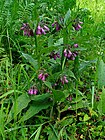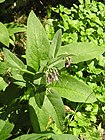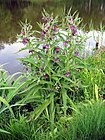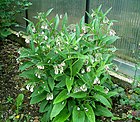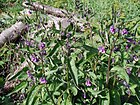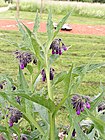Note: This is a project under development. The articles on this wiki are just being initiated and broadly incomplete. You can Help creating new pages.
Difference between revisions of "Symphytum officinale"
| Line 82: | Line 82: | ||
==External Links== | ==External Links== | ||
| − | * [ ] | + | * [http://www.flowersofindia.net/catalog/slides/Comfrey.html#:~:text=Symphytum%20officinale%20%2D%20Comfrey&text=Comfrey%20is%20a%20perennial%20herb,on%20river%20banks%20and%20ditches. Symphytum officinale on flowersofindia.net] |
[[Category:Herbs]] | [[Category:Herbs]] | ||
Latest revision as of 13:08, 17 August 2020
Symphytum officinale is a perennial plant that can grow up to 1.20 metres tall. It is harvested from the wild for local use as a food, medicine and source of materials.
Contents
- 1 Uses
- 2 Parts Used
- 3 Chemical Composition
- 4 Common names
- 5 Properties
- 6 Habit
- 7 Identification
- 8 List of Ayurvedic medicine in which the herb is used
- 9 Where to get the saplings
- 10 Mode of Propagation
- 11 How to plant/cultivate
- 12 Commonly seen growing in areas
- 13 Photo Gallery
- 14 References
- 15 External Links
Uses
Cuts, Bruises, Sprains, Sores, Eczema, Varicose veins, Broken bones, Pulmonary complaints, Internal bleeding.[1]
Parts Used
Chemical Composition
The roots of Symphytum officinale contain pyrrolizidine alkaloids, including symlandine, symphytine, and echimidine.8,9 Other constituents include riddelliine, riddelliine N-oxide, senecionine, senecionine N-oxide, seneciphylline, retrorsine, integerrimine, lasiocarpine and heliotrine.[2]
Common names
| Language | Common name |
|---|---|
| Kannada | |
| Hindi | |
| Malayalam | |
| Tamil | |
| Telugu | |
| Marathi | |
| Gujarathi | |
| Punjabi | |
| Kashmiri | |
| Sanskrit | |
| English |
Properties
Reference: Dravya - Substance, Rasa - Taste, Guna - Qualities, Veerya - Potency, Vipaka - Post-digesion effect, Karma - Pharmacological activity, Prabhava - Therepeutics.
Dravya
Rasa
Guna
Veerya
Vipaka
Karma
Prabhava
Habit
Identification
Leaf
| Kind | Shape | Feature |
|---|---|---|
Flower
| Type | Size | Color and composition | Stamen | More information |
|---|---|---|---|---|
| {{{5}}} |
Fruit
| Type | Size | Mass | Appearance | Seeds | More information |
|---|---|---|---|---|---|
Other features
List of Ayurvedic medicine in which the herb is used
Where to get the saplings
Mode of Propagation
How to plant/cultivate
Tolerates most soils and situations but prefers a moist soil and some shade. Grows well in heavy clay soils. Best grown in an open sunny site in a deep rich soil if it is being grown for compost material.[4]
Commonly seen growing in areas
Often shady localities, In meadows, Especially near streams.
Photo Gallery
References
- ↑ Indian Medicinal Plants by C.P.Khare
- ↑ Chemical constituents
- ↑ [Morphology]
- ↑ Cultivation
External Links
- Pages with broken file links
- Ayurvedic Herbs known to be helpful to treat Cuts
- Ayurvedic Herbs known to be helpful to treat Bruises
- Ayurvedic Herbs known to be helpful to treat Sprains
- Ayurvedic Herbs known to be helpful to treat Sores
- Ayurvedic Herbs known to be helpful to treat Eczema
- Ayurvedic Herbs known to be helpful to treat Varicose veins
- Ayurvedic Herbs known to be helpful to treat Broken bones
- Ayurvedic Herbs known to be helpful to treat Pulmonary complaints
- Ayurvedic Herbs known to be helpful to treat Internal bleeding
- Herbs with Young leaves used in medicine
- Herbs with Rosted seeds used in medicine
- Habit - Perennial
- Index of Plants which can be propagated by Seeds
- Herbs that are commonly seen in the region of Often shady localities
- Herbs that are commonly seen in the region of In meadows
- Herbs that are commonly seen in the region of Especially near streams
- Herbs
